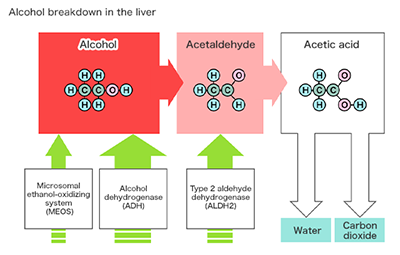Drink at a moderate pace and have a pleasant time
Risks of drinking alcohol
There are also risks associated with drinking.
In order to enjoy it healthily, it is important to have a correct understanding of the risks associated with drinking, such as health problems caused by drinking too much, the dangers of drink-driving, and alcohol-related harassment.
The relationship between blood alcohol concentration and intoxication, and how the liver metabolizes alcohol
There are various states of intoxication, such as being tipsy, drunk, or dead drunk.
We will explain the relationship between blood alcohol concentration and intoxication, as well as the mechanism of sobering up, which is basic knowledge of the risks of drinking alcohol.
Mechanism of Intoxication
What does it mean to “get drunk”?
When you drink alcohol, about 20% of the alcohol is absorbed in the stomach and about 80% in the small intestine, getting into the bloodstream and being transported to the liver via the portal vein.
The liver begins to break down the alcohol, but as it cannot be broken down immediately, most of the alcohol is sent to the heart and then to the brain and the rest of the body. When the alcohol reaches the brain via the bloodstream, it numbs the brain and creates a state of drunkenness. This is what it means to be “drunk.”
It is said that it takes about 30 minutes to 2 hours for the alcohol you drink to reach the brain, so you don't get drunk immediately after drinking alcohol.
Blood alcohol concentration and the state of drunkenness
The degree of intoxication is determined by the concentration of alcohol in the brain. However, it is impossible to actually measure the concentration in the brain, so the degree of intoxication is determined by the concentration of alcohol in the blood instead. (The way people become intoxicated varies from person to person.)
-
*Excerpt from “Alcohol and Health” by the Japan Society of Alcohol Health and Medicine
- Subliminal intoxication
-
Blood alcohol concentration (%) 0.02 - 0.04 Amount of alcohol consumed -
One bottle of beer (up to one bottle)
-
Sake (up to 1 cup)
-
Whisky (up to 2 single drinks)
State of intoxication -
You feel refreshed
-
Your skin turns red
-
You become cheerful
-
Your judgment becomes a little dull

-
- Euphoria
-
Blood alcohol concentration 0.05~0.10 Amount of alcohol consumed -
Medium bottle of beer (1~2 bottles)
-
Sake (1-2 cups)
-
Whiskey (3 shots)
State of intoxication -
Feeling tipsy
-
Hands become more active
-
Loss of inhibition (loss of reason)
-
Body temperature rises
-
Pulse rate increases

-
- The early stage of intoxication
-
Blood alcohol concentration (%) 0.11-0.15 Amount of alcohol consumed -
3 medium-sized bottles of beer
-
3 double shots of whiskey
State of intoxication -
Feelings become more exuberant
-
Yell at the top of your voice
-
Become more irritable
-
Feel unsteady when standing

-
- Confusion
-
Blood alcohol concentration (%) 0.16~0.30 Amount of alcohol consumed -
One medium-sized bottle of beer (4-6 bottles)
-
One bottle of sake (4-6 go)
-
Two double shots of whiskey
State of intoxication -
Wobbly gait
-
Repeating the same thing over and over
-
Rapid breathing
-
Nausea and vomiting

-
- Stupor
-
Blood alcohol concentration (%) 0.31-0.40 Amount of alcohol consumed -
One medium-sized bottle of beer (7 to 10 bottles)
-
One to two bottles of sake (7 to 1800ml)
-
One bottle of whiskey
State of intoxication -
Unable to stand up straight
-
Unclear consciousness
-
Incoherent speech

-
- Coma
-
Blood alcohol concentration (%) 0.41 to 0.50 Amount of alcohol consumed -
10 or more medium-sized beer bottles
-
1 or more 1-sho (1.8 liters) of sake
-
1 or more bottles of whiskey
State of intoxication -
Cannot be roused even by shaking
-
Urine and feces flow uncontrollably
-
Breathing is slow and deep
-
Death

-
How “intoxication” wears off (alcohol metabolism)
Alcohol that enters the body through the mouth is broken down into acetaldehyde by the action of ADH (alcohol dehydrogenase) and MEOS (microsomal ethanol oxidation system) in the hepatocytes that make up the liver. This acetaldehyde is a toxic substance that causes a red face, palpitations, nausea, and headaches when you drink alcohol.
Furthermore, acetaldehyde is broken down into acetic acid (acetate) by the action of the metabolic enzyme ALDH2 (type 2 aldehyde dehydrogenase). Acetic acid is harmless to the human body. As it circulates through the bloodstream, it is broken down into water and carbon dioxide (CO2) and eventually excreted in urine, sweat, and exhaled air.
Any blood alcohol that the liver cannot break down is sent to the heart via the hepatic vein, and from there it circulates through the body before being broken down again in the liver.

Time taken to process alcohol
Even if you drink the same amount of alcohol, the blood alcohol concentration will be lower in people who weigh more, i.e., those with more blood. The ability to process alcohol also differs depending on body weight. In general, the alcohol processing capacity of a person weighing 60-70kg is about 5g of pure alcohol per hour. This is equivalent to about a quarter of a medium-sized bottle of beer or a quarter of a double shot of whiskey. In other words, it takes about four hours to process the alcohol in a bottle of beer, a double shot of whiskey, or a go of sake (180ml).
-
*The ability to process alcohol varies depending on your constitution, weight, and physical condition.
Source
-
ABC Dictionary of Alcohol and Health (Kirin Brewery Company, Limited)
-
Alcohol Health Medical Association “Considering Alcohol and Health”
Let's learn about moderate drinking
Drink in moderation at your own pace
Drinking alcohol in moderation can lead to a rich and enjoyable life.
Since you may have more drinking occasions in your life, it is important to know the right amount and pace for you.
The effects of drinking alcohol vary from person to person, and the impact you receive will differ depending on your age, gender, constitution, etc.
Please decide on an amount that suits you and try to drink it in the way that doesn’t impact your health. When drinking, it is important to be aware of the amount of pure alcohol (g) contained in the alcohol and to keep track of your alcohol intake.
In addition, it has been suggested that the rate at which alcohol is broken down slows down in the elderly and that they can become intoxicated even when their blood alcohol concentration is not high, so the amount of alcohol consumed by people aged 65 and over should be reduced.
Women metabolize alcohol more slowly than men, and even if they drink the same amount per body weight, they are said to be more likely to suffer alcohol-related organ damage.
Furthermore, it is recommended that people who experience a flushing reaction* after drinking alcohol should reduce their alcohol intake, as their bodies take longer to break down alcohol.
-
*The flushing reaction occurs with a small amount of alcohol, such as a single beer mug, and includes symptoms such as a flushed face, nausea, palpitations, drowsiness, and headache.
The amount of pure alcohol is expressed in grams (g) and is calculated using the following formula, considering the specific gravity of alcohol.
Amount of alcohol (ml) x alcohol content or %/100 x 0.8 (specific gravity of alcohol) = amount of pure alcohol (g)
For example, the amount of pure alcohol contained in a 500ml bottle or a tall can of beer with an alcohol content of 5% is:
500 (ml) x 0.05 x 0.8 = 20 (g).
This is not a recommendation for people who do not drink to drink this amount.
The effect of alcohol on the body and mind is based on the amount of pure alcohol consumed, not the amount of the drink consumed.
The Ministry of Health, Labour and Welfare has set the amount of alcohol that increases the risk of lifestyle-related diseases as an average daily intake of pure alcohol of 40g or more for men and 20g or more for women.
It is known that continuing to drink in this way increases the risk of not only lifestyle-related diseases but also other health problems and serious social problems such as violence, abuse, and accidents.
Approximate amount of pure alcohol: 20g
- Beer (5%)
- 500ml
- Sake (15%)
- 180ml
- Wine (12%)
- 200ml
- Chuhai (7%)
- 350ml
- Shochu (25%)
- 100ml
- Whiskey (40%)
- 60ml
5 tips for enjoying alcoholic beverages
Moderate amounts of alcohol can help relieve tension, facilitate communication, and bring joy and enrichment to our daily lives. On the other hand, inappropriate drinking can cause various problems for the drinker, their family, and society. In order to enjoy alcohol for a long time, please keep the following five points in mind.
① Savor it slowly with a meal
If you drink alcohol on an empty stomach, the alcohol will be absorbed quickly from the stomach to the small intestine and then reach the brain via the liver, so that you will get drunk quickly. Also, the alcohol may damage the stomach lining. If you drink while eating, the alcohol will be absorbed slowly, and the rise in blood alcohol concentration will be suppressed.
Eating foods with high fat content, such as cheese, before drinking will protect the stomach lining from the effects of alcohol and also slow down the absorption. High-protein foods, such as edamame, tofu, fish, and meat, promote the regeneration of liver cells and increase the activity of alcohol-metabolizing enzymes. It is also recommended to drink with foods that are high in vitamins, minerals, and dietary fiber. Let's enjoy the marriage of delicious food and alcohol smartly.

② Don't drink for long periods
If you keep drinking for a long time without taking breaks, you will drink more than your limit and end up heavy drinking. Also, you won't be able to metabolize all the alcohol the next day, so you will end up with a hangover. Try to stop drinking within a reasonable time and drink in moderation.

③ Don't force people to drink at your pace
It is important to drink in moderation. Never force people who can't drink or who are not heavy drinkers to drink.
④ Don't forget to have a chaser
To prevent getting drunk, it is important to keep yourself well-hydrated while having a drink . By drinking alcohol and water (chaser) alternately, you can reset your sense of taste and also ease the irritation of alcohol on your stomach and intestines. This also helps to prevent a sudden rise in the alcohol concentration in your blood so that you can enjoy a tipsy feeling for longer. Also, because alcohol has a diuretic effect, it can easily cause dehydration. Make sure you drink plenty of water to help your body flush out alcohol from your system.
⑤ Take two days off from drinking alcohol a week
Take two days off from drinking alcohol a week to look after your body.
To avoid getting a hangover
A hangover is an unpleasant condition that occurs due to a combination of factors, including the fact that the liver cells are unable to sufficiently process the harmful substance acetaldehyde due to the large amount of alcohol consumed, as well as damage to the stomach and intestines caused by alcohol, and dehydration.
Preventing a hangover
The best way to prevent a hangover is to “stick to your limit.” Drinking until late at night or drinking heavily is a no-no. Also, if you drink on an empty stomach, the alcohol will be absorbed quickly, causing you to feel sick and get a hangover. Try to drink while eating. When eating, try to eat mainly foods high in protein and vitamins.
What if you drink too much?
It takes time for the body to break down alcohol. Get plenty of sleep and drink plenty of water. It is also recommended to eat foods that contain sugar and vitamin C, which help to break down acetaldehyde.
Some say to get rid of a hangover drinking is helpful, but this will only increase the alcohol concentration in the blood again, so even if you temporarily forget the unpleasant symptoms, you will often be hit by even worse discomfort later, so you should never do this.
10 Rules for Moderate Drinking
These are the 10 Rules for Moderate Drinking to help you responsibly enjoy alcohol.
-
1.The basic rule is to drink while having fun and enjoying yourself.
-
2.While eating, drink slowly within the recommended limits.
-
3.It is recommended to dilute strong alcohol.
-
4.Let's take a break from drinking two days a week.
-
5.Let's not drink for a long time without taking breaks.
-
6.Don’t allow it. Pushing others to drink too much at once.
-
7.Alcohol is dangerous when taken with medicine
-
8.Don't drink alcohol when you are pregnant or breastfeeding
-
9.Exercise and bathing after drinking should be avoided
-
10.Don't forget to have regular check-ups for your liver and other organs
Source
Ministry of Health, Labour and Welfare e-Health Net, HEALTH AND MEDICINE OF ALCOHOL ASSOCIATION